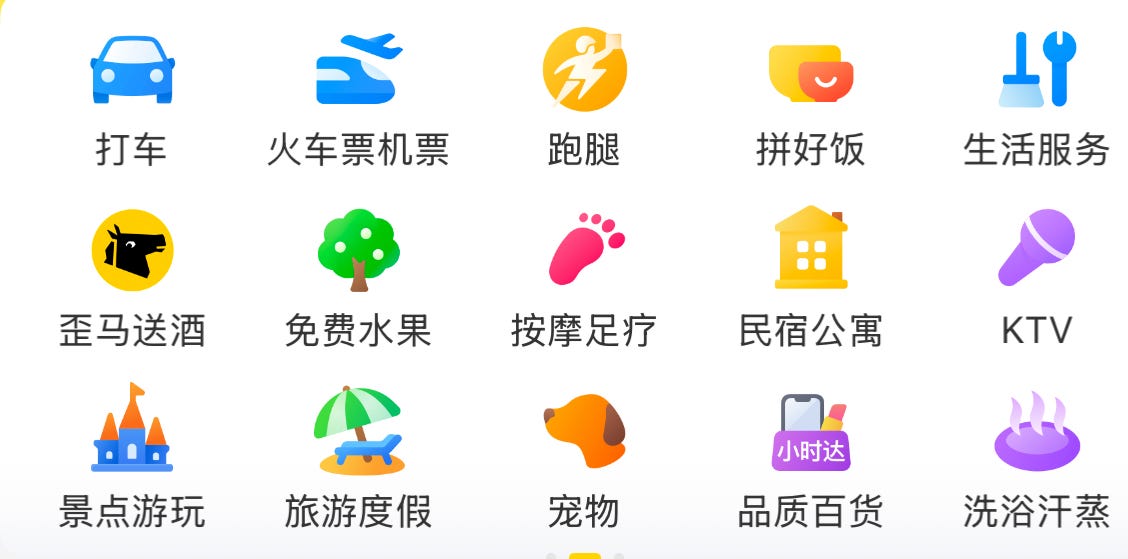Platform Ambitions in China: How Trying to Sell Everything Burns Billions
China’s cut-throat competition makes even market leaders bleed billions when they venture outside their core business.
Why Expanding What You Sell Is Much Harder Than It Looks
Lately, I’ve been obsessing over business models—not out of academic curiosity, but because of some very real questions surfacing inside my own company. After talking to a few marketing experts, and revisiting some books, I started noticing patterns I had conveniently ignored. It turns out that even billion-dollar giants can fall into the same traps as I did. And somehow still manage to explain it away on earnings calls like it’s all part of the plan.
One question kept nagging at me: does having a strong business model (like a platform business model) actually make it easier to expand into new categories? The textbook says yes. Reality says: not so fast.
This piece is a reflection—part investment note, part therapy session.
Line Extensions
Marketing people call this idea “line extension” — selling something close to what you already offer. It sounds painless: if you already sell shampoo, why not deodorant? Reality disagrees.
If it were easy, Procter & Gamble would market one omnipotent “Super-Clean” brand covering every household chore; instead it keeps separate labels for laundry, dishes and floors to protect its flagships. Cross-selling just does not work so easily. Only 30% of U.S. packaged-goods line extensions survive two years.
And that is still within cleaning — not even across completely different categories.
Even the strongest companies can fail. Coca-Cola tried to enter the coffee market with Coke Blak — and it disappeared quickly despite Coca-Cola’s distribution network and marketing power. Amazon Fresh was supposed to change how people buy groceries. Yet most people still think of Amazon as the place for electronics or other goods, not fresh food.
Platform business models
In investing, there are many approaches. Some investors buy great companies with great models. Others buy “cigar butts” — cheap, struggling businesses that have one good puff left. I have written about this before your style of investing should align with your personality. And you don’t have to limit yourself to one type of investments. This is a costly mental bias.
Studying strong business models is always worth the time. Platform businesses, in particular, drew early attention. When they first rose to fame, they were seen as the alpha predators—dominant, untouchable.
The focus was all on user engagement. The logic was straightforward: the more people interacted with your platform, the more you could sell. But was that ever really true, or did we just convince ourselves that attention was the same as value?
User engagement - the holy grail? Case study Meituan
Meituan seemed to do everything right. They bought Mobike (bike rentals) and entered the power bank rental business as well. Both are familiar sights if you live in China. I have said it before — Meituan is by far the most visible of the Chinese tech companies. Everywhere you walk in China, you can see their trademark yellow color — whether on bikes, power banks, or delivery riders.
Both businesses — bike rentals and power banks — are terrible on their own (they are also small in scale that’s why Meituan never talks about them in details): asset-heavy, labor-intensive, and barely profitable. Bikes constantly need to be collected, repaired, and redistributed. Every day, you can see Meituan workers rounding up bikes all over the city.
The financial results are not great either. I personally bought a monthly bike pass for about $2 USD - it is clearly subsidized.
So why did Meituan invest in these businesses?
They served as cheap customer acquisition tools. Every time someone rented a bike or borrowed a power bank, they had to download and open the Meituan app.
This increased daily engagement and lowered user acquisition costs.
When combined with food delivery — another high-frequency touchpoint with consumers — Meituan achieved very high user engagement. Possibly the highest among all Chinese platform businesses.
This led many people, myself included, to believe that Meituan would easily expand into travel bookings, ride-hailing, and dominate these fields. After all, who books flights every day? Compared to Ctrip, Meituan had a huge advantage in user engagement — people opened the Meituan app almost daily. It seemed like a strong position to build from. But it didn’t work out that way. Ctrip still dominates travel bookings, and Meituan partly pulled back from ride-hailing. Meituan’s ride-hailing DAU leapt +300 % in one month during heavy voucher subsidies, then fell −41 % within three months after the incentives ended.
The great tragedy of science — the slaying of a beautiful hypothesis by an ugly fact.
Thomas Henry Huxley
In hindsight, I should have seen it earlier from my own behavior. Despite using Meituan more than once a day on average, I still book hotels through Ctrip and use Didi for ride-hailing. Expansion beyond food delivery turned out to be much harder than expected, no matter how strong the user engagement. The only real success was moving from cooked food into groceries and now instant retail.
So why was expanding into other areas so difficult?
Keep reading with a 7-day free trial
Subscribe to The Great Wall Street to keep reading this post and get 7 days of free access to the full post archives.






